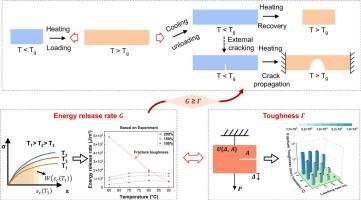Spontaneous fracture in shape memory polymers: Temperature-activated and constraint-induced fracture from programming
IF 5.3
2区 工程技术
Q1 MECHANICS
引用次数: 0
Abstract
Shape memory polymers (SMPs), distinguished by their unique properties such as variable stiffness and shape memory effect, have exhibited extensive application potential. However, despite the promising applications of SMPs, their viscoelastic fracture behavior and mechanism, particularly under various loading conditions and thermal stimuli, remain insufficiently explored. This study investigates the thermo-activated viscoelastic fracture behavior of SMPs under constrained recovery and the variations in fracture toughness under different loading conditions. Thermally responsive SMPs were fabricated, and pure shear fracture tests were conducted, revealing that fracture toughness decreases significantly with increasing temperature and decreasing loading rate, attributed to reduced viscoelastic dissipation. Notably, spontaneous crack propagation is observed in stretch-programmed SMPs under thermal activation, with higher programmed stretch ratios leading to lower self-rupture temperatures. To explain this phenomenon, a viscoelastic fracture framework is established incorporating temperature-dependent relaxation and recovery strain, validated by experiments and finite element simulations. The proposed energy release rate model accurately predicts critical rupture temperatures, providing a reliable framework for failure prediction in programmable smart materials. This work bridges thermomechanical behavior and fracture mechanics, offering design insights for SMP-based structures in soft robotics and biomedical applications.

形状记忆聚合物的自发断裂:由程序引起的温度激活和约束诱导断裂
形状记忆聚合物(SMPs)以其可变刚度和形状记忆效应等独特的特性,显示出广泛的应用潜力。然而,尽管SMPs具有很好的应用前景,但其粘弹性断裂行为和机制,特别是在各种载荷条件和热刺激下,仍然没有得到充分的研究。研究了约束恢复条件下SMPs的热活化粘弹性断裂行为,以及不同加载条件下SMPs的断裂韧性变化。制备了热响应型SMPs,并进行了纯剪切断裂试验,结果表明,随着温度的升高和加载速率的降低,SMPs的断裂韧性显著降低,这主要是由于粘弹性耗散的减少。值得注意的是,在热激活的拉伸程序SMPs中观察到自发裂纹扩展,较高的编程拉伸比导致较低的自破裂温度。为了解释这一现象,通过实验和有限元模拟验证了粘弹性断裂框架,该框架包含了温度相关的松弛和恢复应变。提出的能量释放率模型能准确预测临界断裂温度,为可编程智能材料的失效预测提供了可靠的框架。这项工作连接了热力学行为和断裂力学,为软机器人和生物医学应用中基于smp的结构提供了设计见解。
本文章由计算机程序翻译,如有差异,请以英文原文为准。
求助全文
约1分钟内获得全文
求助全文
来源期刊
CiteScore
8.70
自引率
13.00%
发文量
606
审稿时长
74 days
期刊介绍:
EFM covers a broad range of topics in fracture mechanics to be of interest and use to both researchers and practitioners. Contributions are welcome which address the fracture behavior of conventional engineering material systems as well as newly emerging material systems. Contributions on developments in the areas of mechanics and materials science strongly related to fracture mechanics are also welcome. Papers on fatigue are welcome if they treat the fatigue process using the methods of fracture mechanics.

 求助内容:
求助内容: 应助结果提醒方式:
应助结果提醒方式:


